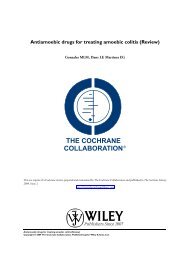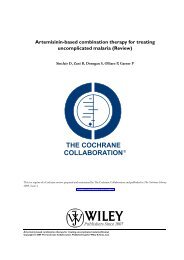Legislative smoking bans for reducing secondhand smoke exposure ...
Legislative smoking bans for reducing secondhand smoke exposure ...
Legislative smoking bans for reducing secondhand smoke exposure ...
You also want an ePaper? Increase the reach of your titles
YUMPU automatically turns print PDFs into web optimized ePapers that Google loves.
Northern Ireland. Similar legislation restricting <strong>smoking</strong> further in<br />
the hospitality sector has been implemented in Italy, Spain, Malta<br />
and France. Smoking ban legislation is usually preceded and often<br />
followed by public awareness activities, as well as interventions to<br />
promote <strong>smoking</strong> cessation such as those outlined in NICE 2007.<br />
Smoking <strong>bans</strong> and restrictions may have the potential to affect<br />
a large number of individuals in a population at minimal cost<br />
and to create a supportive environment <strong>for</strong> those who want to<br />
quit, thereby helping people who continue <strong>smoking</strong> to reduce<br />
their tobacco consumption. Fichtenberg 2002, in a review of the<br />
effects of totally <strong>smoke</strong>-free workplaces on daily consumption and<br />
<strong>smoking</strong> prevalence, estimated that such policies reduced <strong>smoking</strong><br />
prevalence by 3.8%. An earlier review, however, although detecting<br />
reduced daily consumption in totally <strong>smoke</strong>-free work sites, was<br />
not able definitively to separate this effect from possible secular<br />
trends (Chapman 1999). The stable long-term effect of <strong>bans</strong> and<br />
restrictions remains an open question.<br />
O B J E C T I V E S<br />
The overall objective is to assess the extent to which <strong>smoking</strong> <strong>bans</strong><br />
or restrictions reduce tobacco consumption, <strong>smoking</strong> prevalence,<br />
and <strong>exposure</strong> to <strong>secondhand</strong> <strong>smoke</strong>.<br />
Primary objectives:<br />
Does the imposition of <strong>bans</strong> or restrictions have an effect on <strong>exposure</strong><br />
to <strong>secondhand</strong> <strong>smoke</strong>?<br />
Does the imposition of <strong>bans</strong> or restrictions reduce tobacco consumption<br />
and <strong>smoking</strong> prevalence in the area affected by the ban<br />
or policy?<br />
Secondary objective:<br />
What effect does the imposition of <strong>bans</strong> or restrictions have on<br />
the <strong>smoking</strong>-related morbidity and mortality of those affected by<br />
the ban or restriction?<br />
M E T H O D S<br />
Criteria <strong>for</strong> considering studies <strong>for</strong> this review<br />
Types of studies<br />
We considered studies that report <strong>smoking</strong> <strong>bans</strong> which have been<br />
implemented as a result of legislation. The <strong>smoking</strong> ban must<br />
operate at national, state or community level. We do not include<br />
in this review settings-based <strong>bans</strong>, such as in workplaces, where<br />
<strong>smoking</strong> has been partially or comprehensively restricted, though<br />
not necessarily as a result of national or state-level legislation.<br />
The minimum standard was having a ban explicitly in the study<br />
and a minimum of six months follow up <strong>for</strong> measures of <strong>smoking</strong><br />
behaviour. We searched <strong>for</strong> randomized controlled trials, quasi-experimental<br />
studies (i.e. non-randomized controlled studies), controlled<br />
be<strong>for</strong>e-and-after studies and interrupted-time series, as defined<br />
by the Cochrane Effective Practice and Organization of Care<br />
Group (EPOC 2009 ) and uncontrolled pre- and post-ban data.<br />
Types of participants<br />
Smokers and non<strong>smoke</strong>rs exposed to comprehensive or partial<br />
<strong>smoking</strong> <strong>bans</strong>. The <strong>bans</strong> must be implemented by legislation or<br />
policy-making, and may affect populations at a local, regional, or<br />
national level.<br />
Types of interventions<br />
<strong>Legislative</strong> <strong>bans</strong> which either ban <strong>smoking</strong> completely (comprehensive)<br />
or restrict it to designated areas (partial). For controlled<br />
studies, the intervention setting may be compared to settings without<br />
<strong>smoking</strong> <strong>bans</strong> or with less restrictive policies. The ban may be<br />
implemented at national, regional or local level.<br />
Types of outcome measures<br />
The primary outcome measures are:<br />
1. Measures of <strong>exposure</strong> to <strong>secondhand</strong> <strong>smoke</strong> among those affected<br />
by the ban, including:<br />
a) measurement of biological markers of <strong>exposure</strong> in physiological<br />
fluids e.g. cotinine, or in expired air<br />
b) self-reported <strong>exposure</strong> to SHS<br />
2. Measures of <strong>smoking</strong> behaviour among those affected by the<br />
ban, including:<br />
a) prevalence of tobacco use<br />
b) tobacco consumption<br />
c) cessation rates<br />
The secondary outcome measure is:<br />
Measures of health outcomes relating to morbidity and mortality,<br />
e.g. cardiac admissions, respiratory health, and pulmonary function.<br />
In studies with longer follow up, measures of the incidence<br />
of lung cancer and cardiovascular disease may also be available.<br />
We preferred biochemically verified <strong>smoking</strong> cessation over self<br />
report, and sustained or prolonged cessation over point prevalence<br />
cessation. We preferred biochemical verification of <strong>exposure</strong><br />
to environmental tobacco <strong>smoke</strong> over self-reported perceptions.<br />
However, we did not exclude studies which did not verify these<br />
measures biochemically. In order to assess sustained impact, we<br />
included studies which reported outcomes such as <strong>smoking</strong> behaviour<br />
at least six months after the start of the <strong>smoking</strong> restriction<br />
<strong>Legislative</strong> <strong>smoking</strong> <strong>bans</strong> <strong>for</strong> <strong>reducing</strong> <strong>secondhand</strong> <strong>smoke</strong> <strong>exposure</strong>, <strong>smoking</strong> prevalence and tobacco consumption (Review)<br />
Copyright © 2010 The Cochrane Collaboration. Published by John Wiley & Sons, Ltd.<br />
4








